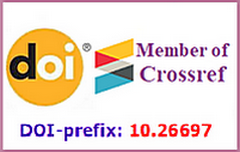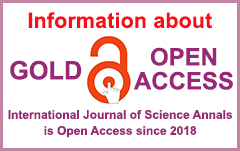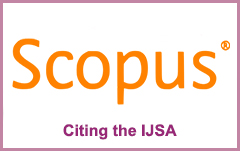Serra L.1,2, Guerreiro C.3, Silva L.4
| 1 Autonomous University of Lisbon, Portugal 2 Centre of Statistics and its Applications of the University of Lisbon, Portugal 3 Higher Institute of Intercultural and Transdisciplinary Studies of Almada – Piaget Institute of Almada, Portugal 4 NOVA School of Science and Technology – NOVA University Lisbon, Portugal |
Abstract
Background and Aim of Study: The physical performance that children exhibit when engaging in sports or any form of physical activity will depend not only on their physical abilities but also on their psychological and cognitive attributes.
The aim of the study: to analyze whether symptoms of anxiety, lie, attention, and age are predictors of arithmetic abilities in children practicing sports.
Material and Methods: The study sample consisted of 108 children with an average age of 12.12 (±2.18) who practice various sports, with greater emphasis on futsal and soccer. The study protocol consisted of a sociodemographic questionnaire, the Revised Children’s Manifest Anxiety Scale, the d2 Test of Attention, and the Arithmetic subtest of the Wechsler Intelligence Scale for Children.
Results: The results showed that through the adjusted model, we identify four significant explanatory variables that are predictors of arithmetic abilities, namely anxiety symptoms (β=-0.009, p=0.009); and the attention sub-factors: processed characters (β=0.002, p=3.44e-14), default errors (β=-0.005, p=0.000), errors by marking irrelevant characters (β=-0.016, p=0.003).
Conclusions: The presence of anxiety symptoms and attentional cognitive abilities play a significant role in predicting the arithmetic aptitudes of young individuals. These variables should be taken into consideration within training programs for young athletes, as they hold relevance for sports engagement.
Keywords
sports participants, anxiety, lie, attention, age, arithmetic skills
References
Anobile, G., Stievano, P., & Burr, D. (2013). Visual sustained attention and numerosity sensitivity correlate with math achievement in children. Journal of Experimental Child Psychology, 16(2), 380-391. https://doi.org/10.1016/j.jecp.2013.06.006
Aragón, E., Serrano, N., & Navarro, J. I. (2018). Do boys and girls learn the same way? A preliminary study in primary education analyzing gender differences. Electronic Journal of Research in Educational Psychology, 16(3), 537-553. https://doi.org/10.25115/ejrep.v16i46.2234
Barrocas, R., Roesch, S., Dresen, V., Moeller, K., & Pixner, S. (2020). Embodied numerical representations and their association with multi-digit arithmetic performance. Cognitive Processing, 21(1), 95-103. https://doi.org/10.1007/s10339-019-00940-z
Becker, D. R., McClelland, M. M., Geldhof, G. J., Gunter, K. B., & MacDonald, M. (2018). Open-skilled sport, sport intensity, executive function, and academic achievement in grade school children. Early Education and Development, 29(7), 939-955. https://doi.org/10.1080/10409289.2018.1479079
Bransford, J. D., & Stein, B. S. (1993). The ideal problem solver: A guide for improving thinking, learning, and creativity (2nd ed.). W. H. Freeman and Company. https://www.tntech.edu/cat/pdf/useful_links/idealproblemsolver.pdf
Brickenkamp, R., & Zillmer, E. (2010). The d2 test of attention [manual]. Hogrefe. https://www.worldcat.org/title/935291577
Broadbent, D. E. (1958). Perception and communication. Pergamon Press. https://www.communicationcache.com/uploads/1/0/8/8/10887248/d_e._broadbent_-_perception_and_communication_1958.pdf
Butterworth, B. (2005). The development of arithmetical abilities. Journal of Child Psychology and Psychiatry, 46(1), 3-18. https://doi.org/10.1111/j.1469-7610.2004.00374.x
Carlson, R. A., Avraamides, M. N., Cary, M., & Strasberg, S. (2007). What do the hands externalize in simple arithmetic? Journal of Experimental Psychology: Learning, Memory, and Cognition, 33(4), 747-756. https://doi.org/10.1037/0278-7393.33.4.747
Carrascosa, J. (2003). Saber competir: Claves para soportar y superar la presion [Knowing how to compete: Keys to withstand and overcome pressure]. Gymnos. https://sabercompetir.com/publicaciones/
Coe, D. P., Pivarnik, J. M., Womack, C. J., Reevees, M. J., & Malina, R. M. (2006). Effect of physical education and activity levels on academic achievement in children. Medicine and Science in Sports and Exercise, 38(8), 1515-1519. https://doi.org/10.1249/01.mss.0000227537.13175.1b
Costa, A., & Pinho, M. S. (2010). Sugestionabilidade interrogativa em crianças de 8 e 9 anos de idade [Interrogative suggestibility in 8 and 9 year old children]. Análise Psicológica, 1(28), 193-208. https://doi.org/10.14417/ap.266
Crollen, V., & Noël, M. P. (2015). The role of fingers in the development of counting and arithmetic skills. Acta Psychologica (Amst), 156, 37-44. https://doi.org/10.1016/j.actpsy.2015.01.007
Deutsch, J. A., & Deutsch, D. (1963). Attention: Some theoretical considerations. Psychological Review, 70(1), 80-90. https://doi.org/10.1037/h0039515
Dias, P., & Gonçalves, M. (1999). Avaliação da ansiedade e da depressão em crianças e adolescentes (STAIC-C2, CMAS-R, FSSC-R e CDI): Estudo normativo para a população portuguesa [Assessment of anxiety and depression in children and adolescents (STAIC-C2, CMAS-R, FSSC-R and CDI): Normative study for the Portuguese population]. In A. P. Soares, S. Araújo, & S. Caires (Eds.), Avaliação Psicológica: Formas e Contextos / VII Conferência Internacional (pp. 553-564). APPORT. https://sigarra.up.pt/flup/pt/pub_geral.pub_view?pi_pub_base_id=12274
Ding, X. P., Heyman, G. D., Sai, L., Yuan, F., Winkielman, P., Fu, G., & Lee, K. (2018). Learning to deceive has cognitive benefits. Journal of Experimental Child Psychology, 76(2018), 26-38. https://doi.org/10.1016/j.jecp.2018.07.008
Evans, A. D., & Lee, K. (2011). Verbal deception from late childhood to middle adolescence and its relation to executive functioning skills. Developmental Psychology, 47(4), 1108-11166. https://dx.doi.org/10.1037%2Fa0023425
Gashaj, V., Oberer, N., Mast, F. W., & Roebers, C. M. (2019a). Individual differences in basic numerical skills: The role of executive functions and motor skills. Journal of Experimental Child Psychology, 182(June), 187-195. https://doi.org/10.1016/j.jecp.2019.01.021
Gashaj, V., Oberer, N., Mast, F. W., & Roebers, C. M. (2019b). The relation between executive functions, fine motor skills, and basic numerical skills and their relevance for later mathematics achievement. Early Education and Development, 30(7), 913-926. https://doi.org/10.1080/10409289.2018.1539556
Hill, F., Mammarella, C., Devine, A., Caviola, S., Passolunghi, M. C., & Szücs, D. (2016). Maths anxiety in primary and secondary school students: Gender differences, developmental changes and anxiety specificity. Learning and Individual Differences, 48(May), 45-53. https://doi.org/10.1016/j.lindif.2016.02.006
Hopko, D. R., McNeil, D. W., Gleason, P. J., & Rabalais, A. E. (2002). The emotional Stroop paradigm: Performance as a function of stimulus properties and self-reported mathematics anxiety. Cognitive Therapy and Research, 26, 157-166. https://doi.org/10.1023/A:1014578218041
Hosker, D. K., Elkins, R. M., & Potter, M. P. (2019). Promoting mental health and wellness in youth through physical activity, nutrition, and sleep. Child and Adolescent Psychiatric Clinics of North America, 28(2), 171-193. https://doi.org/10.1016/j.chc.2018.11.010
Landerl, K. (2013). Development of numerical processing in children with typical and dyscalculic arithmetic skills – A longitudinal study. Frontiers in Psychology, 4, Article 459. https://doi.org/10.3389/fpsyg.2013.00459
Maggioni, M. A., & Rossignoli, D. (2020). Clever little lies: Math performance and cheating in primary schools in Congo. Journal of Economic Behavior & Organization, 172(C), 380-400. https://doi.org/10.1016/j.jebo.2019.12.021
Matias, D., Leime, J., Amorim, C., Bezerra, G., & Torro-Alves, N. (2015). Lying: Social and neurobiological aspects. Psicologia: Teoria e Pesquisa, 31(3), 397-401. https://doi.org/10.1590/0102-37722015032213397401
Michel, E., Molitor, S., & Schneider, W. (2020). Executive functions and fine motor skills in kindergarten as predictors of arithmetic skills in elementary school. Developmental Neuropsychology, 45(6), 367-379. https://doi.org/10.1080/87565641.2020.1821033
Nogues, C. P., & Duro, M. L. (2016, July 13-16). Desenvolvimento da estimativa numérica e desempenho em aritmética em crianças: Um estudo comparativo entre tarefas [Development of numerical estimation and arithmetic performance in children: A comparative study between tasks]. XII Encontro Nacional de Educação Matemática, São Paulo, Brasil. https://www.sbem.com.br/enem2016/anais/pdf/7105_3110_ID.pdf
Ommundsen, Y., Roberts, G. C., Lemyre, P. N., & Treasure, D. (2003). Perceived motivational climate in male youth soccer: Relations to social-moral functioning, sportspersonship and team norm perceptions. Psychology of Sport and Exercise, 4(4), 397-413. https://doi.org/10.1016/S1469-0292(02)00038-9
Orbach, L., Herzog, M., & Fritz, A. (2020). State- and trait-math anxiety and their relation to math performance in children: The role of core executive functions. Cognition, 200, Article 104271. https://doi.org/10.1016/j.cognition.2020.104271
Pizzie, R., McDermott, C., Salem, T., & Kraemer, D. (2020). Neural evidence for cognitive reappraisal as a strategy to alleviate the effects of math anxiety. Social Cognitive and Affective Neuroscience, 15(12), 1271-1287. https://doi.org/10.1093/scan/nsaa161
Rapin, I. (2016). Dyscalculia and the calculating brain. Pediatric Neurology, 61, 11-20. https://doi.org/10.1016/j.pediatrneurol.2016.02.007
Reeve, R., Reynolds, F., Humberstone, J., & Butterworth, B. (2012). Stability and change in markers of core numerical competencies. Journal of Experimental Psychology: General, 141(4), 649-666. https://doi.org/10.1037/a0027520
Sailors, P. R., Teetzel, S., & Weaving, C. (2017). Cheating, lying, and trying in recreational sports and leisure practices. Annals of Leisure Research, 20(5), 563-577. https://doi.org/10.1080/11745398.2017.1284009
Salminen, J., Koponen, T., & Tolvanen, A. (2018). Individuality in the early number skill components underlying basic arithmetic skills. Frontiers in Psychology, 9, Article 1056. https://doi.org/10.3389/fpsyg.2018.01056
Simões, M. R. (2002). Utilizações da WISC-III na avaliação neuropsicológica de crianças e adolescents [Uses of the WISC-III in the assessment neuropsychological of children it is adolescent]. Paidéia (ribeirão Preto), 12(23), 113-132. https://doi.org/10.1590/S0103-863X2002000200009
Steele, A., Karmiloff-Smith, A., Cornish, K., & Scerif, G. (2012). The multiple subfunctions of attention: Differential developmental gateways to literacy and numeracy. Child Development, 83(6), 2028-2041. https://doi.org/10.1111/j.1467-8624.2012.01809.x
Storbeck, J., & Clore, G. L. (2007). On the interdependence of cognition and emotion. Cognition and Emotion, 21(6), 1212-1237. https://doi.org/10.1080/02699930701438020
Syväoja, H., Kankaanpää, A., Hakonen, H., Inkinen, V., Kulmala, J., Joensuu, L., Räsänen, P., Hillman, C., & Tammelin, T. (2021). How physical activity, fitness, and motor skills contribute to math performance: Working memory as a mediating factor. Scandinavian Journal of Medicine & Science in Sports, 31(12), 2310-2321. https://doi.org/10.1111/sms.14049
Swanson, H. L., & Beebe-Frankenberger, M. (2004). The relationship between working memory and mathematical problem solving in children at risk and not at risk for serious math difficulties. Journal of Educational Psychology, 96(3), 471-491. https://doi.org/10.1037/0022-0663.96.3.471
Tamorri, S. (2004). Neurociencias y deporte: Psicología deportiva. Procesos mentales del atleta [Neurosciences and sports: Sports psychology. Athlete’s mental processes]. Paidotribo. https://dialnet.unirioja.es/servlet/libro?codigo=390056
Vallée-Tourangeau, F. (2013). Interactivity, efficiency, and individual differences in mental arithmetic. Experimental Psychology, 60(4), 302-311. https://doi.org/10.1027/1618-3169/a000200
Vukovic, R., Kieffer, M., Bailey, S., & Harari, R. (2013). Mathematics anxiety in young children: Concurrent and longitudinal associations with mathematical performance. Contemporary Educational Psychology, 38(1), 1-10. https://doi.org/10.1016/j.cedpsych.2012.09.001
Wechsler, D. (2003). Escala de inteligência de Wechsler para crianças (WISC-III) [Wechsler intelligence scale for children (WISC-III)] (M. R. Simões, M. J. Seabra-Santos, C. P. Albuquerque, M. Pereira, A. M. Rocha, C. Ferreira, Trans.). Cegoc. (Original work published 1991). https://cineicc.uc.pt/wisc-iii-wisc-iii-info/
Wong, T., & Liu, D. (2020). The association between visual attention and arithmetic competence: The mediating role of enumeration. Journal of Experimental Child Psychology, 196, Article 104864. https://doi.org/10.1016/j.jecp.2020.104864
Wu, S., Chen, L., Battista, C., Watts, A., Willcutt, E., & Menon, V. (2017). Distinct influences of affective and cognitive factors on children’s non-verbal and verbal mathematical abilities. Cognition, 166, 118-129. https://doi.org/10.1016/j.cognition.2017.05.016
Serra Lidia (Corresponding Author) – https://orcid.org/0000-0003-2612-3335;
Guerreiro Cristiana – https://orcid.org/0009-0007-4820-6269; Master’s degree in Clinical and Health Psychology, Higher Institute of Intercultural and Transdisciplinary Studies of Almada – Piaget Institute of Almada, Almada, Portugal.
Silva Luís – https://orcid.org/0000-0001-9811-0571; Doctor in Human Kinetics – Motor Behavior, Investigator, NOVA School of Science and Technology – NOVA University Lisbon, Caparica, Portugal.
| |
APA
Serra, L., Guerreiro, C., & Silva, L. (2023). Prediction of arithmetic abilities of children who practice sports: The use of the gamma model. International Journal of Science Annals, 6(2), 10–18. https://doi.org/10.26697/ijsa.2023.2.1
Harvard
Serra, L., Guerreiro, C., & Silva, L. 2023. "Prediction of arithmetic abilities of children who practice sports: The use of the gamma model". International Journal of Science Annals, [online] 6(2), pp. 10–18. viewed 25 December 2023, https://culturehealth.org/ijsa_archive/ijsa.2023.2.1.pdfVancouver
Serra L., Guerreiro C., & Silva L. Prediction of arithmetic abilities of children who practice sports: The use of the gamma model. International Journal of Science Annals [Internet]. 2023 [cited 25 December 2023]; 6(2): 10–18. Available from: https://culturehealth.org/ijsa_archive/ijsa.2023.2.1.pdf https://doi.org/10.26697/ijsa.2023.2.1












